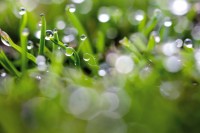Liquid fertilizers – the flexible choice in warm, dry weather
 Turf managers can be apprehensive about applying fertilizer in the warm, dry summer months, particularly those without access to irrigation, but it's the choice of fertilizer that's crucial for turf safety, according to Scotts' international technical manager, Stuart Staples.
Turf managers can be apprehensive about applying fertilizer in the warm, dry summer months, particularly those without access to irrigation, but it's the choice of fertilizer that's crucial for turf safety, according to Scotts' international technical manager, Stuart Staples.
The unseasonably warm weather the UK has experienced this spring have bought this issue to the fore, including the driest March for 50 years and April's temperatures reaching a sizzling 28 degrees centigrade.
"With turf entering a natural growth peak, it's important to provide the essential nutrients it needs to develop colour, vigour and density," he explains.
"Fertilizers with a high salt Index will have a high osmotic potential, and this can lead to dehydration of plant cells as water moves from a solution with a low salt level, to a solution with a high salt level until an equilibrium is reached."
"It is essential to minimise salt loading during hot, dry weather. Checking the nutrient sources of your fertilizers can dramatically improve turf safety, for example, potassium chloride (KCl) has a much higher salt index versus potassium sulphate (K2SO4). The fertilizer selection could benefit further by using a slow release or controlled release fertilizer that spoon feeds nutrients, and hence salts, gradually over time, never excessively raising salt levels."
When it's warm, liquid applications can be a good alternative to conventional granular applications. They allow very low nutrient levels to be applied on a more frequent basis to avoid high salt concentrations on the leaf.
But Stuart also urges caution when selecting a liquid fertilizer.
"One potential problem with them is that beads of water can form on the leaf surface and act as prisms, concentrating the sun's rays and causing damage to the leaf. Greenmaster Liquids overcome this problem because they contain spreaders that prevent beads of water forming. They are also manufactured from low salt index nutrient sources that minimise burn potential. The TMax technology and added stabilizers in Scotts' Greenmaster Liquids provide a safe, reliable way of feeding your turf without scorching," Stuart adds.
"Because the safety of our products is our foremost priority, Greenmaster Liquids were tested at four times the recommended label rate as part of the company's new product development programme. They are successfully used in many countries around the world that experience long periods of high temperatures, including Spain, Italy, Greece and Australia."
Here are Scotts' top tips for foliar spraying in warm weather:
• If possible, spray in cool conditions (< 26 deg C)
• Ideally, spray on overcast days
• Early morning or evening sprays produce better results, as stomata are more likely to be open
• Spray should contain small amounts of nitrogen, which acts as a nutrient absorption enhancer
• Spray as fine a mist as possible whilst avoiding drift
• Use low water volumes to keep more of the spray solution on the target area
• Do not mow or irrigate within three hours of application to optimise foliar nutrient uptake
Greenmaster Liquids are available in 10 litre packs, and also in 200 litre drums with a pump, from Scotts distributors. To locate your nearest distributor, visit www.scottsprofessional.co.uk.
